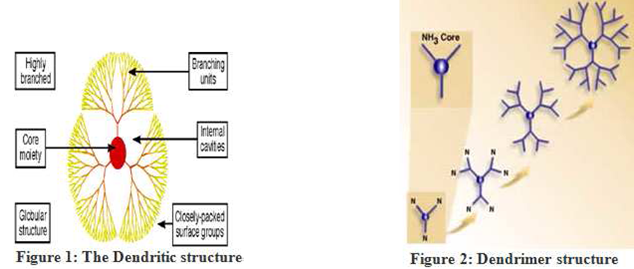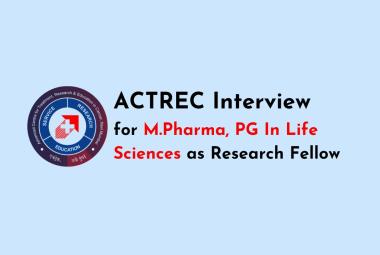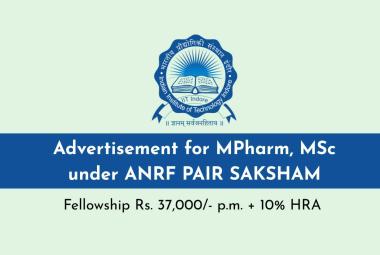 About Author
About Author
Manish kumar
Hindu College Of Pharmacy, Sonipat
*maggarwal0007@gmail.com
Abstract:
Dendrimers are perfect monodisperse macromolecules(poloymers) with regular and highly branched 3-D structure. Dendrimers have often been referred to as the “Polymer of the 21st century. They are characterized by branch upon branch architecture which are completely different from traditional Polymers. Exceptional feature of a dendrimer includes a high degree of structural symmetry, a density gradient displaying an intra-molecular minimum value and a well defined number of terminal groups. Dendrimers are normally used as carriers for drug delivery especially for oral, ocular and transdermal delivery. Oral drug delivery system are very important to the field of medicine, since most of the common illness are treated via oral route. Encapsulation and conjugation of drug with dendrimers have shown immerse employment for delivery of hydrophobic and labile drugs. Anticancer and antihypertensive drugs are most promising candidates for oral route using dendrimer as carrier. Dendrimers drug delivery system are therefore increasingly viewed as an advantageous for bioactive like drugs and gene. Although dendrimer drug delivery requires attention to certain manufacturing and biological consideration to be successful.
[adsense:336x280:8701650588]
REFERENCE ID: PHARMATUTOR-ART-1723
INTRODUCTION:
Dendrimers are a class of regularly branched mono-dispersed polymer having 5-10 nanometers in diameter.The term dendrimer is derived fromtwo words, the Greek word ‘dendron’, meaning tree, and ‘meros’, meaning part. Dendrimers posses three distinguishing architectural components:
(a)an initiator core, (b) interior layers composed of repeating units radially attached to the initiator core, and (c)exterior attached to the outermost interior generation.
Dendrimers provide a route to create very well-defined nanostructures suitable for drug solubilization applications, delivery of DNA and oligonucletide, targeting drug at specific receptor site, and ability to act as carrier for the development of drug delivery system.

CLASSIFICATION :
1.Simple dendrimers:They have simple monomer units e.g. poly(amidoamine) dendrimers composed of poly(amidoamine) segments named as “starburst” dendrimers.
2.Chiral dendrimer: The chirality in these dendrimers is basedupon the construction of constitutionally different but chemically similar branches to an achiral core.
3.Liquid crystalline dendrimers: They consist of mesogenic (liq. crystalline) monomers e.g. mesogen functionalized carbosilane dendrimers.
4.Hybrid dendrimers: Hybrid dendrimers are combination ofdendritic and linear polymers in hybrid block or graft copolymer forms.
5.Amphiphilic Dendrimers: They are built with two segregated sites ofchain end, one half is electron donating andthe other half is electron withdrawing.
6.Micellar Dendrimers: These are unimolecular micelles of water soluble hyper branched polyphenylenes.
[adsense:468x15:2204050025]
SYNTHESIS OF DENDRIMER:
Divergent growth method:This wasintroduced by Tomalia, called as
“divergentmethod” in which growth of dendrimersoriginates from a core site.This method exhibits the unique feature of transferring molecular level information from the initiator core,generation to generation. In this method, the core isreacted with two or more moles of reagentcontaining at least two protecting branchingsites, followed by removal of the protecting groups. The subsequent liberated reactive sites lead to the first generation dendrimers. This process is repeated until the dendrimer of the described size is obtained.

Convergent growth method: Convergent growth begins at what will endup being the surface of the dendrimer andworks inwards by gradually linking surfaceunits together with more. When the growingwedges are large enough, several areattached to a suitable core to give a completedendrimer. The advantages of convergentgrowth over divergent growth stem that onlytwo simultaneous reactions are required forany generation-adding step.Convergent method involves two stages: (1) a reiterative coupling of protected branch to produce a focal point functionalized dendron, followed by (2) a divergent core anchoring step to produce various multidendron dendrimers.

NOW YOU CAN ALSO PUBLISH YOUR ARTICLE ONLINE.
SUBMIT YOUR ARTICLE/PROJECT AT articles@pharmatutor.org
Subscribe to Pharmatutor Alerts by Email
FIND OUT MORE ARTICLES AT OUR DATABASE
MOLECULAR MODELLING OF DENDRIMERS:
The model of Gennes & Hervet (1983) suggests a density minimum at the center of dendrimer and predicts that ideal dendritic growth will only occur a certain generation is reached, at which point steric congestion will prevent further growth.This was later called as “starburst effect” by Tomalia,(1994).Lescanec & Muthukumar (1990) kinetic model of dendritic growth predicts maximum density at core of dendrimer and the ends of branches are not positioned at the surface but are severely folded.Self mean field model Boris& Rubinstein (1996) showed the maximum density at the core due to uniform distribution of end groups throughout the volume of dendrimer.Monte Carlo showed a dramatic change in dendrimer conformation upon addition of electrolyte. At high ionic strength, backfolding of end groups takes place and a dense core dendritic structure is formed.At low ionic strengts, the molecule is stretched out to form a dense shell.

APPLICATION OF DENDRIMER:
1.Solubilization: The dendrimer resembling micelles are formed when the surface of an apolar dendrimer contains charged functional groups.A unimolecular micelle of polyaryl ether dendrimers was prepared and used to investigate solubilization of nonpolar organic molecules.The dendrimer could solubilize as low as 5 x 10-7mol/L concentration while SLS required its critical micelle concentration i.e 8.1 x 10-3 mol/L.
2. Dendrimers based drug delivery:
High charge density on dendrimers opens wide scope for making drug as well as metal-based complexes for targeted drug therapy. “Methotrexate-dendrimer complex” have prepared for improved cancer therapy. This complex was found to be pH dependent and remains stable at physiological pH and targeted in the brain and bone marrow.
3. Dendrimer as magnetic resonance imaging contrast agents:
A number of research groups have explored the use of dendrimers as a new class of high molecular weight MRI contrast agents. Wiener and coworkers developed a series of Gd(III)–DTPA-based PAMAM dendrimers.To improve the pharmacokinetic properties of dendrimer contrast agents, introduction of target specific moieties to the dendritic MRI contrast agents have been considered. Wiener et al synthesized a folate conjugated Gd(III)–DTPA PAMAM dendrimer, which increased the longitudinal relaxation rate of tumor cells expressing the high affinity folate receptor.
4. Dendrimers in gene delivery:
Dendrimer-based transfection agents have become routine tools for many molecular and cell biologist’s dendrimers are extensively used as non-viral vector for gene delivery. The use of dendrimers as gene transfection agents and drug-delivery devices have been extensively reviewed part.Various polyatomic compound such as PEI, polylysine, and cationic have been utilized as non-viral gene carrier.
5. Dendrimers in photodynamic therapy:
The photosensitizer 5-aminolevulinic acidhas been attached to the surface ofdendrimers and studied as an agent for PDT of tumorigenic keratinocytes.Thiscancer treatment involve the administrationof a light-activated photosensitizing drugthat selectively concentrates in diseased tissue.
6. Dendritic Catalysts / Enzymes:
The combination of high surface area and high solubility makes dendrimers useful as nanoscale catalysts. Dendrimers have a multifunctional surface and all catalytic sites are always exposed towards the reaction mixture. They can be recovered from the reaction mixture by easy ultra filtration methods.Because of their ‘pseudo’-spherical nature and their resultant conformations the metal sites in these well-de?ned polymeric catalysts should be easily accessible for substrate molecules and reagents, and therefore exhibit characteristics- fast kinetics, speci?city and solubility.e.g Catalysis with phosphine-based dendrimers.
CONCLUSION:
The dendrimers possess unique properties, such as high degree of branching, multivalency, globular architecture and well-defined molecular weight,makes dendrimer ideal carriers for the various applications like drug delivery,theruputic and diagnostic agent.A large number of drugs being developed today facing problems of poor solubility, bioavailability and permeability. Dendrimers can work as a useful tool for optimizing drug delivery of such problematic drugs. Also the problem of biocompatibility and toxicity can be overcome.
This review clearly illustrate the various aspect of dendrimer makes them as a novel polymer for drug delivery system.
REFERENCES :
1. N.K.Jain, Editor, Advances in controlled and novel drug delivery, CBS Publishers & Distributors, New Delhi.,361–380.
2. Tomalia, D.A., Baker, H., Dewald, J., Hall, M.,Kallos, G and Martin, S., 1985. A newclass of polymers: starburst-dendritic macromolecules. Polym J., 17, 117-32.
3. Newcome, G.R., Moorefield, C.N and Vogtle, F.,1996. Dendritic Molecule Concept, synthesisPrespective,VCH publisher.
NOW YOU CAN ALSO PUBLISH YOUR ARTICLE ONLINE.
SUBMIT YOUR ARTICLE/PROJECT AT articles@pharmatutor.org
Subscribe to Pharmatutor Alerts by Email
FIND OUT MORE ARTICLES AT OUR DATABASE









